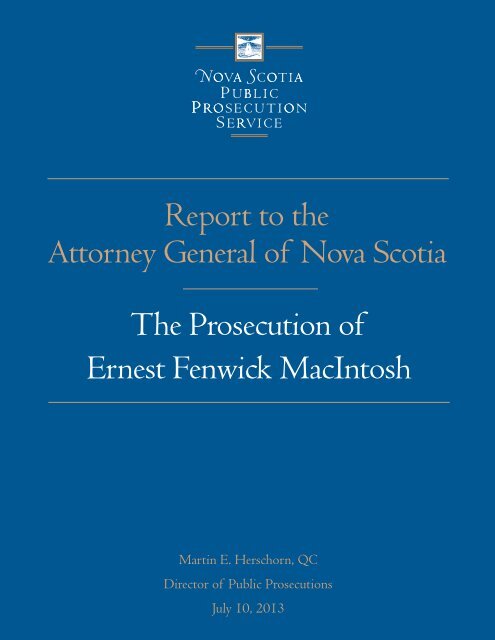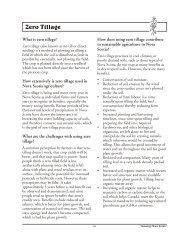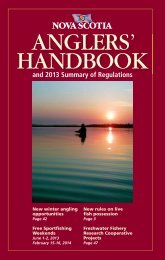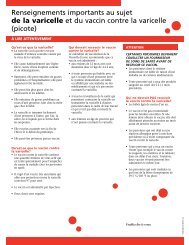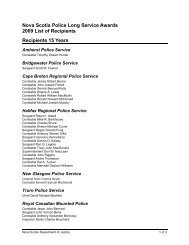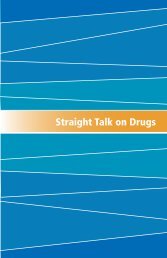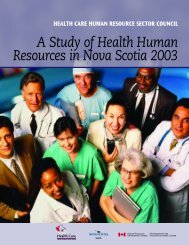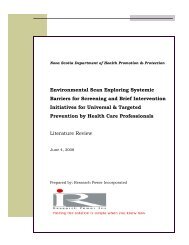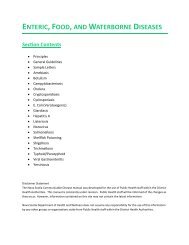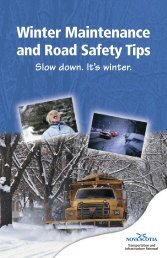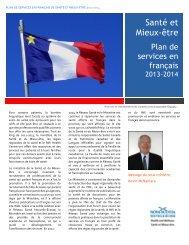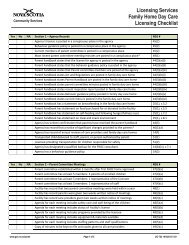The Prosecution of Ernest Fenwick MacIntosh July 10
The Prosecution of Ernest Fenwick MacIntosh July 10
The Prosecution of Ernest Fenwick MacIntosh July 10
Create successful ePaper yourself
Turn your PDF publications into a flip-book with our unique Google optimized e-Paper software.
Table <strong>of</strong> ContentsTable <strong>of</strong> Contents ..............................................................................................................................1Table <strong>of</strong> Figures..................................................................................................................................2Nova Scotia Public <strong>Prosecution</strong> Service........................................................................................3Introduction..........................................................................................................................................4Role <strong>of</strong> the Crown Attorney............................................................................................................5Overview <strong>of</strong> R. v. <strong>Ernest</strong> <strong>Fenwick</strong> <strong>MacIntosh</strong>............................................................................6<strong>The</strong> First Complaint.................................................................................................................6Passport........................................................................................................................................6Preparing for Extradition.........................................................................................................7Obtaining Sworn Affidavits.....................................................................................................8Extradition Proceedings in India............................................................................................8Court Proceedings in Canada..................................................................................................8Committed to Stand Trial.....................................................................................................<strong>10</strong>Undue Delay Application......................................................................................................<strong>10</strong><strong>The</strong> First Trial..........................................................................................................................11<strong>The</strong> Second Trial.....................................................................................................................11Appeals Heard..........................................................................................................................12<strong>The</strong> Extradition Process Explained.................................................................................................... 9Outcome <strong>of</strong> Criminal Charges.....................................................................................................13Significant Causes <strong>of</strong> Delay in <strong>MacIntosh</strong> Case.....................................................................16Bringing <strong>Ernest</strong> <strong>Fenwick</strong> <strong>MacIntosh</strong> Back to Canada.....................................................16Back in Canada, Bringing <strong>Ernest</strong> <strong>Fenwick</strong> <strong>MacIntosh</strong> to Trial.....................................20Actions Going Forward..................................................................................................................22Longer Term Actions to Address Systemic Delay...................................................................23Conclusion .........................................................................................................................................24AppendixTimeline <strong>of</strong> Key Events.........................................................................................................25Report to the Attorney General <strong>of</strong> Nova Scotia <strong>The</strong> <strong>Prosecution</strong> <strong>of</strong> <strong>Ernest</strong> <strong>Fenwick</strong> <strong>MacIntosh</strong> 1
Table <strong>of</strong> FiguresFigure 1 - Outcome <strong>of</strong> Criminal Charges.........................................................13Figure 2 - Criminal Code Cases Prosecuted byPort Hawkesbury Office - 1996 - 2008............................................................18Figure 3 - Provincial Statute Cases Prosecuted byPort Hawkesbury Office - 1996 - 2008............................................................192 Report to the Attorney General <strong>of</strong> Nova Scotia <strong>The</strong> <strong>Prosecution</strong> <strong>of</strong> <strong>Ernest</strong> <strong>Fenwick</strong> <strong>MacIntosh</strong>
Nova ScotiaPublic <strong>Prosecution</strong> Service<strong>The</strong> Nova Scotia Public <strong>Prosecution</strong> Service wasestablished in 1990 as the first statutorily-basedindependent prosecution service in Canada.All prosecutions within the jurisdiction <strong>of</strong>the Attorney General <strong>of</strong> Nova Scotia are theresponsibility <strong>of</strong> the Director <strong>of</strong> Public <strong>Prosecution</strong>s.Crown Attorneys, responsible to the Director<strong>of</strong> Public <strong>Prosecution</strong>s, conduct prosecutionsindependently <strong>of</strong> the Attorney General.<strong>The</strong> only limitation on the operationalindependence <strong>of</strong> the Director <strong>of</strong> Public<strong>Prosecution</strong>s permitted by the Public <strong>Prosecution</strong>sAct arises when the Attorney General issues writteninstructions to the Director <strong>of</strong> Public <strong>Prosecution</strong>s.<strong>The</strong>se instructions are binding and must be madepublic. This procedure preserves the ultimateprosecutorial authority <strong>of</strong> the Attorney General.This is a means <strong>of</strong> ensuring accountability tothe electorate for the manner in which publicprosecutions are conducted.Report to the Attorney General <strong>of</strong> Nova Scotia <strong>The</strong> <strong>Prosecution</strong> <strong>of</strong> <strong>Ernest</strong> <strong>Fenwick</strong> <strong>MacIntosh</strong> 3
IntroductionThis is a review <strong>of</strong> the prosecution <strong>of</strong> <strong>Ernest</strong><strong>Fenwick</strong> <strong>MacIntosh</strong>, the subject <strong>of</strong> an historicalsexual assault case involving nine complainants. Itfocuses specifically on process and the length <strong>of</strong>time it took for that process to unfold.A thorough examination <strong>of</strong> all the documentsrelated to the case was conducted. Thisencompassed thousands <strong>of</strong> documents going backto 1995. In addition to consulting with appellateand trial counsel, input was obtained from theCrown Attorney in Port Hawkesbury who handledthe file primarily from its beginning in 1995 until hisappointment to the Provincial Court in November2009, and from the former Chief Crown Attorneyfor Cape Breton Region from 1995 until hisappointment to the Supreme Court <strong>of</strong> Nova Scotiain <strong>July</strong>, 2008.This report seeks to explain – not excuse – the timeperiods involved throughout.This review has disclosed a lack <strong>of</strong> diligence andoversight in the management <strong>of</strong> this file which isclearly unacceptable. <strong>The</strong> review includes a series<strong>of</strong> actions which the PPS is now taking to avoid areoccurrence <strong>of</strong> such a situation in the future.4 Report to the Attorney General <strong>of</strong> Nova Scotia <strong>The</strong> <strong>Prosecution</strong> <strong>of</strong> <strong>Ernest</strong> <strong>Fenwick</strong> <strong>MacIntosh</strong>
Role <strong>of</strong> the Crown AttorneyTo provide context to this report, anexplanation <strong>of</strong> the role and function <strong>of</strong> theCrown Attorney is necessary.Crown Attorneys are responsible to theDirector <strong>of</strong> Public <strong>Prosecution</strong>s for conductingall aspects <strong>of</strong> prosecutions includingarraignments, show cause (bail hearings),preliminary inquiries, trials, sentencings,appeals to the Supreme Court <strong>of</strong> Nova Scotia,appeals to the Nova Scotia Court <strong>of</strong> Appealand appeals to the Supreme Court <strong>of</strong> Canada.In addition, Crown Attorneys provide prechargeadvice to the police and provincialgovernment enforcement <strong>of</strong>ficials, uponrequest.It is important to note that Crown Attorneysare not investigators and do not lay criminalcharges. Investigations into alleged criminalacts are conducted by the police. <strong>The</strong> policedecide whether to lay a charge. After a chargeis laid a Crown Attorney decides whether acharge should go forward. <strong>The</strong> Crown Attorneymakes that decision by reviewing all theevidence and deciding:• if there is a realistic prospect <strong>of</strong> conviction;and• if it is in the public interest to proceed.If the answer is affirmative in both casesthe Crown Attorney will proceed with aprosecution.A detailed policy on prosecutorial discretiondescribes the process <strong>of</strong> determining theviability <strong>of</strong> a criminal charge. This policy isone a series <strong>of</strong> policies which guide CrownAttorneys in the exercise <strong>of</strong> their duties. (<strong>The</strong>Crown Attorney Policy Manual is publiclyavailable on the PPS website at www.gov.ns.ca/pps/)It is also important to understand that when amatter goes to trial the Crown Attorney’s roleis to present the evidence fairly. <strong>The</strong> CrownAttorney argues for the proper verdict basedupon the evidence. <strong>The</strong> Crown Attorney is notaiming to “win” a conviction.When handling a prosecution, CrownAttorneys must represent the interests <strong>of</strong>the general public. <strong>The</strong> Crown Attorney isnot the victim’s lawyer. <strong>The</strong>re are times whenthe Crown Attorney must disagree with thewishes <strong>of</strong> the victim. Crown Attorneys havea responsibility to treat victims <strong>of</strong> crimewith compassion and respect. Often, CrownAttorneys call upon Victims’ Services workers <strong>of</strong>the Nova Scotia Department <strong>of</strong> Justice to helpexplain the prosecution process to the victim.<strong>The</strong>y prepare the victim for court appearancesand keep them informed <strong>of</strong> progress on thecase.Sometimes a verdict, a sentence or a specialorder made by a judge may be appealed byeither the Crown or an accused. <strong>The</strong> defencehas more flexibility when it comes to appeals.<strong>The</strong> Crown cannot initiate an appeal justbecause it disagrees with a decision; appealsinitiated by the Crown must be based on errorsmade by a trial judge on a point <strong>of</strong> law.Each year 90 Crown Attorneys in 18 <strong>of</strong>ficesacross the province handle about 50,000Criminal Code charges and about <strong>10</strong>,000provincial regulatory <strong>of</strong>fence charges.Report to the Attorney General <strong>of</strong> Nova Scotia <strong>The</strong> <strong>Prosecution</strong> <strong>of</strong> <strong>Ernest</strong> <strong>Fenwick</strong> <strong>MacIntosh</strong> 5
Overview <strong>of</strong> R. v. <strong>Ernest</strong> <strong>Fenwick</strong> <strong>MacIntosh</strong><strong>The</strong> First ComplaintIn 1995 a man entered a British Columbia RCMPdetachment to report that as a boy growing upin Port Hawkesbury, Nova Scotia in the 1970s hehad been sexually assaulted by area businessman<strong>Ernest</strong> <strong>Fenwick</strong> <strong>MacIntosh</strong>.And so began one <strong>of</strong> the longest and one <strong>of</strong> themost complex historical sexual assault cases NovaScotia has seen. It would involve nine complainantsand 43 criminal charges. It would see a fugitivebrought back to Canada from India and it wouldsee a journey all the way to the Supreme Court<strong>of</strong> Canada in an attempt to bring that fugitive tojustice.By the end <strong>of</strong> 1995 two criminal charges had beenlaid. <strong>The</strong> criminal complaint came about six monthsafter Mr. <strong>MacIntosh</strong> had left Canada to work first inCalifornia and then in India.A warrant was issued for his arrest in early 1996.<strong>The</strong> RCMP was trying to locate Mr. <strong>MacIntosh</strong>through family and friends in the Port Hawkesburyarea. On August 25, 1996 the investigator wasgiven a phone number in India and made the call.He spoke to Mr. <strong>MacIntosh</strong> and told him <strong>of</strong> thecriminal charges and the warrant for his arrest. Mr.<strong>MacIntosh</strong> told the <strong>of</strong>ficer he had no intention <strong>of</strong>coming back to Canada and the line went dead.<strong>The</strong> local Crown Attorney conferred with theCape Breton Region Chief Crown Attorney whodiscussed the matter with Nova Scotia Public<strong>Prosecution</strong> Service management in Halifax. Allagreed that the charges were serious and that itwas in the public interest to pursue extradition.Throughout this period <strong>of</strong> time, the RCMPcontinued the criminal investigation and consultedwith the Crown on various options to return Mr.<strong>MacIntosh</strong> to Canada without a formal extraditionprocess.Meanwhile, the first complainant in BritishColumbia had begun writing letters to BCauthorities asking that they help to bring Mr.<strong>MacIntosh</strong> back to Canada and to justice. <strong>The</strong>ydirected him to their Nova Scotia counterparts. Hebegan to write to politicians, both provincial andfederal, asking for the same thing.PassportIn late 1997 the RCMP asked Canada Immigrationand Passport to red-flag Mr. <strong>MacIntosh</strong> withCustoms in the event he re-entered the country. Ifhe did, he would be arrested. <strong>The</strong> Passport <strong>of</strong>ficeinitiated an application to have Mr. <strong>MacIntosh</strong>’spassport revoked. It had just been renewed in May,1997 from where Mr. <strong>MacIntosh</strong> resided in India.Although passport revocation proceedings wereinitiated, they were inexplicably halted. <strong>The</strong> FederalDepartment <strong>of</strong> Justice and the Passport <strong>of</strong>fice sentletters to both Mr. <strong>MacIntosh</strong> and his lawyer datedApril 16, 1998. <strong>The</strong> letters advised that the decisionto revoke the passport had been withdrawn andconfirmed a resumption <strong>of</strong> “normal passportservices.” But the provincial Crown Attorneywas unaware <strong>of</strong> these 1998 events until theseletters were submitted by the defence in courtproceedings in 2009.6 Report to the Attorney General <strong>of</strong> Nova Scotia <strong>The</strong> <strong>Prosecution</strong> <strong>of</strong> <strong>Ernest</strong> <strong>Fenwick</strong> <strong>MacIntosh</strong>
Overview <strong>of</strong> R. v. <strong>Ernest</strong> <strong>Fenwick</strong> <strong>MacIntosh</strong>Preparing for Extradition<strong>The</strong> International Assistance Group (IAG) <strong>of</strong>the Federal Department <strong>of</strong> Justice is the entityresponsible for the extradition process. In 1997the IAG and the Port Hawkesbury Crown Attorneybegan to talk about the case, how the process <strong>of</strong>extradition works and what was necessary to bringMr. <strong>MacIntosh</strong> back to Canada. <strong>The</strong> Nova ScotiaPublic <strong>Prosecution</strong> Service formally asked the IAGin 1998 to begin working on the extradition <strong>of</strong> Mr.<strong>MacIntosh</strong>.Because <strong>of</strong> the unusual nature <strong>of</strong> this case -- oneinvolving an extradition request -- the Special<strong>Prosecution</strong>s section <strong>of</strong> the Nova Scotia Public<strong>Prosecution</strong> Service got involved. <strong>The</strong> Special<strong>Prosecution</strong>s Crown Attorney liaised with theIAG to clarify whether dual criminality could beestablished. Under international extradition law, theextraditing country -- in this case, India -- must besatisfied that the <strong>of</strong>fence in the requesting country– Canada -- is also an <strong>of</strong>fence there.Meanwhile, local area publicity had broughtanother complainant to the RCMP. Two morecharges were laid in 1999 and in the spring <strong>of</strong> 2000,the Crown Attorney in Port Hawkesbury becameaware <strong>of</strong> several potential complainants. He askedthe RCMP to put the investigator on the case fulltime.This RCMP <strong>of</strong>ficer was familiar with the PortHawkesbury area and could provide consistencythroughout the course <strong>of</strong> the investigation.to India. Under extradition law, the principle <strong>of</strong>specialty dictated that the accused could only beprosecuted for the charges specified at the time <strong>of</strong>extradition. It would not be possible to extraditehim on the first few charges and prosecute him onothers that arose later. So, the investigation wouldhave to be thorough and complete.One challenge early in the investigation was theabsence <strong>of</strong> a quality photo <strong>of</strong> Mr. <strong>MacIntosh</strong>. Policewere having difficulty with photographic line-upsfor identification purposes. <strong>The</strong> first complainantcouldn’t identify Mr. <strong>MacIntosh</strong> due to the poorquality <strong>of</strong> the photo being used. So, the RCMPbegan efforts to acquire a current and good qualityphoto from Mr. <strong>MacIntosh</strong>’s passport file. Policereceived that photo in May, 2000.During 2000 and 2001 the police investigationwidened. Statements from seven morecomplainants were taken and charges nownumbered 43. <strong>The</strong> charges consisted mostly <strong>of</strong>multiple counts <strong>of</strong> indecent assault on a male andacts <strong>of</strong> gross indecency. Several complainantssuccessfully identified Mr. <strong>MacIntosh</strong> fromphotographic line-ups.Also in 2001, aware that Mr. <strong>MacIntosh</strong>’s passportwould be up for renewal in May <strong>of</strong> 2002, the RCMPconfirmed that Mr. <strong>MacIntosh</strong> remained on thePassport Control List in the event he attempted torenew his passport.<strong>The</strong> Crown Attorney had been cautioned by theIAG that all possible charges must be laid beforea formal extradition request can be forwardedReport to the Attorney General <strong>of</strong> Nova Scotia <strong>The</strong> <strong>Prosecution</strong> <strong>of</strong> <strong>Ernest</strong> <strong>Fenwick</strong> <strong>MacIntosh</strong> 7
Overview <strong>of</strong> R. v. <strong>Ernest</strong> <strong>Fenwick</strong> <strong>MacIntosh</strong>Obtaining Sworn AffidavitsBy April <strong>of</strong> 2002, the police investigation had mademajor progress and the Crown Attorney informedthe IAG that Nova Scotia would like to proceed withextradition. But the IAG was now asking for swornaffidavits from all <strong>of</strong> the complainants. <strong>The</strong> Crownbegan to gather these affidavits. Complicating thiseffort was a geographic reality. Complainants livedacross Canada and in the United States. Repeatedletters to some complainants yielded no results.In September, 2002 the RCMP notified the Crownthat Mr. <strong>MacIntosh</strong>’s passport had been renewed inMay, 2002.In June 2003 the Crown sent all the documentationit had to the IAG despite the fact that fourcomplainants had not submitted a sworn affidavit.<strong>The</strong> Crown Attorney heard nothing from the IAG for11 months. So, the Crown contacted the IAG again.<strong>The</strong> IAG now advised that a detailed affidavit fromthe lead investigator would suffice in the absence<strong>of</strong> affidavits from the remaining four complainants.It took almost two years to finalize this affidavit. OnMay 24, 2006 the lead investigator’s affidavit wassent to the IAG.Extradition Proceedings in IndiaIn <strong>July</strong> <strong>of</strong> 2006, Canada made a formal request toIndia to extradite <strong>Ernest</strong> <strong>Fenwick</strong> <strong>MacIntosh</strong>.It took almost a year before Mr. <strong>MacIntosh</strong>was arrested in New Delhi on April 5, 2007. Hecontested the extradition. After satisfying itselfthat dual criminality existed; that the <strong>of</strong>fences withwhich he was charged in Canada were also criminal<strong>of</strong>fences in India, the Indian Court ruled on April25, 2007 that Mr. <strong>MacIntosh</strong> should be extradited.<strong>The</strong> Government <strong>of</strong> India accepted the Court’sruling and on May 26, 2007 agreed to extradite Mr.<strong>MacIntosh</strong>.An RCMP team <strong>of</strong> <strong>of</strong>ficers then went to India, tookMr. <strong>MacIntosh</strong> into custody and began the journeyback to Canada on June 6, 2007.Court Proceedings in CanadaUpon his return, Mr. <strong>MacIntosh</strong> was takenimmediately to Port Hawkesbury and on June8, 2007 a six year court process began. He wasarraigned in Provincial Court and a date was set fora bail hearing. Bail was denied.On <strong>July</strong> 23, 2007 the defence announced itwas seeking documentation from the federalgovernment on the extradition and requested thatelection and/or plea be adjourned pending anapplication challenging the extradition. Electionand/or plea was adjourned a total <strong>of</strong> five times atthe request <strong>of</strong> the defence. <strong>The</strong> Crown argued thedocumentation requested by the defence wasimmaterial to the issue <strong>of</strong> election; that what wasinitially disclosed to the defence was sufficient toaddress the criminal case.Finally, on May 7, 2008, the defence elected to betried by judge alone in Supreme Court and witha preliminary inquiry. Dates for the preliminaryinquiry were set for October, 2008 with two days inJanuary, 2009 if necessary.Meanwhile, in March <strong>of</strong> 2008 the Judge hadordered Mr. <strong>MacIntosh</strong>’s release on recognizanceand under strict conditions.8 Report to the Attorney General <strong>of</strong> Nova Scotia <strong>The</strong> <strong>Prosecution</strong> <strong>of</strong> <strong>Ernest</strong> <strong>Fenwick</strong> <strong>MacIntosh</strong>
<strong>The</strong> Extradition Process ExplainedWhat Is It?Extradition is a diplomatic process by whichCanada may request the return <strong>of</strong> an individualfound in another country to stand trial withrespect to a crime committed in Canada, orto return a person found in another countryconvicted in Canada, and who has not yetserved his or her sentence. <strong>The</strong> governinglegislation in Canada is the Extradition Act,S.C. 1999, c. 18. <strong>The</strong> Extradition Act applies torequests made by foreign countries for thesurrender <strong>of</strong> fugitives within Canada’s territoryand to requests made by Canada for the return<strong>of</strong> an accused person to Canada.How does it work?Canada has extradition treaties with manycountries. Extradition treaties set out the<strong>of</strong>fences for which extradition is possible andinclude any applicable limitation periods andcertain <strong>of</strong>fences, such as those <strong>of</strong> a politicalnature, for which extradition is not applicable.An extradition treaty also determines thenature <strong>of</strong> the extradition materials which mustbe presented as part <strong>of</strong> an extradition request.<strong>The</strong>se materials may include:• Affidavits setting out the facts <strong>of</strong> the alleged<strong>of</strong>fences. <strong>The</strong>se would include evidencerespecting the identity <strong>of</strong> theaccused person, certified copies <strong>of</strong> chargingdocuments, and certified copies <strong>of</strong> arrestwarrants; and• one or more affidavits <strong>of</strong> law setting out theapplicable Canadian criminal law respectingthe <strong>of</strong>fences charged.<strong>The</strong> Principle <strong>of</strong> Dual CriminalityThis principle requires that an <strong>of</strong>fence forwhich extradition is sought to Canada exists inthe foreign jurisdiction.<strong>The</strong> Principle <strong>of</strong> SpecialtyThis principle has been codified in Section80 <strong>of</strong> the Extradition Act. It dictates that aprosecution may proceed only with respectto the specific <strong>of</strong>fences for which the <strong>of</strong>fenderwas surrendered. This means it is essentialthat all complaints brought to police are fullyinvestigated and all possible charges againsta fugitive are part <strong>of</strong> an extradition request,before that extradition request is made.How is Extradition ActuallyRequested?<strong>The</strong> request for extradition must be initiatedby a competent prosecution authority. It is theAttorney General <strong>of</strong> this Province who makes arequest to the <strong>of</strong>fice <strong>of</strong> the Federal Minister <strong>of</strong>Justice. Within the Federal Department <strong>of</strong> Justiceis the International Assistance Group (IAG). Thisgroup provides advice to provincial <strong>of</strong>ficials withrespect to the extradition process, reviews requestsand determines if an extradition request shouldbe forwarded to a foreign country. Extraditionprocedures include provision for seeking aprovisional arrest warrant <strong>of</strong> an accused in a foreigncountry. <strong>The</strong> request for a provisional arrest warrantis appropriate particularly where there is a risk <strong>of</strong>flight by a fugitive from his current location.<strong>The</strong>re are two common law principles relevantto requests for extradition.Report to the Attorney General <strong>of</strong> Nova Scotia <strong>The</strong> <strong>Prosecution</strong> <strong>of</strong> <strong>Ernest</strong> <strong>Fenwick</strong> <strong>MacIntosh</strong> 9
Overview <strong>of</strong> R. v. <strong>Ernest</strong> <strong>Fenwick</strong> <strong>MacIntosh</strong>On May 23, 2008 a defence motion to prohibit theextradition order was heard in the Nova ScotiaSupreme Court. It was dismissed June 19, 2008.An effort to stay the preliminary inquiry, pendingappeal <strong>of</strong> this decision, was dismissed in <strong>July</strong>, 2008.<strong>The</strong> defence appealed the Nova Scotia SupremeCourt’s ruling on prohibition <strong>of</strong> the extraditionorder to the Nova Scotia Court <strong>of</strong> Appeal. Thatappeal was dismissed in December, 2008.Committed to Stand TrialAt the end <strong>of</strong> the preliminary inquiry in January <strong>of</strong>2009 Mr. <strong>MacIntosh</strong> was committed to stand trialon 36 out <strong>of</strong> 43 charges. <strong>The</strong> judge did not agree tocommit Mr. <strong>MacIntosh</strong> on seven charges involvingthree complainants.In the Spring <strong>of</strong> 2009 the defence proposed thatthe remaining charges be severed into two trials.<strong>The</strong> first trial would deal with charges involvingtwo complainants who are brothers as well as athird who is their cousin. <strong>The</strong> second trial woulddeal with charges involving the remaining threecomplainants. <strong>The</strong> Crown consented and the firsttrial was scheduled for November, 2009.counsel for the prosecution. That senior CrownAttorney assumed primary responsibility for thefile after the Port Hawkesbury Crown Attorney wasappointed to the provincial court in November2009.Undue Delay Application<strong>The</strong> trial was delayed until the hearing on unduedelay could be held. Nova Scotia Supreme CourtChief Justice Joseph Kennedy heard arguments onFebruary <strong>10</strong>, 20<strong>10</strong>. Five weeks later he ruled againstthe defence. He was satisfied the defence wasresponsible for a significant portion <strong>of</strong> the delayboth prior to extradition and after Mr. <strong>MacIntosh</strong>was back in Canada. He denied Mr. <strong>MacIntosh</strong>’srequest that charges be stayed on the basis <strong>of</strong>undue delay.But the defence filed a notice <strong>of</strong> motion to theNova Scotia Supreme Court on September 29, 2009asking that all proceedings be stayed due to unduedelay. It argued that Mr. <strong>MacIntosh</strong>’s Charter rightswere violated both by the delay caused by theextradition process and by delay in getting him totrial once he was back in Canada.Just after Mr. <strong>MacIntosh</strong> was arrested in New Delhi,a Senior Crown Attorney in Special <strong>Prosecution</strong>sand based in Sydney was assigned to be co-<strong>10</strong> Report to the Attorney General <strong>of</strong> Nova Scotia <strong>The</strong> <strong>Prosecution</strong> <strong>of</strong> <strong>Ernest</strong> <strong>Fenwick</strong> <strong>MacIntosh</strong>
Overview <strong>of</strong> R. v. <strong>Ernest</strong> <strong>Fenwick</strong> <strong>MacIntosh</strong><strong>The</strong> First TrialIn April <strong>of</strong> 20<strong>10</strong> the first trial began in PortHawkesbury Supreme Court. Justice SimonMacDonald presided.<strong>The</strong> six day trial wrapped up on <strong>July</strong> 9, 20<strong>10</strong>. JusticeMacDonald rendered his verdict on <strong>July</strong> 27, 20<strong>10</strong>.He found Mr. <strong>MacIntosh</strong> guilty on 13 counts andnot guilty on 13 counts.Almost immediately the defence filed a Notice <strong>of</strong>Appeal from conviction with the Nova Scotia Court<strong>of</strong> Appeal.On September 28, 20<strong>10</strong> Mr. <strong>MacIntosh</strong> wassentenced to four years in prison less time servedon remand. He was also ordered to provide asample to the DNA databank and was given alifetime ban on weapons.<strong>The</strong> Crown had asked for eight years in prison lesstime served on remand, a DNA order, a lifetimeweapons prohibition and to be registered as asex <strong>of</strong>fender under the Sex Offender InformationRegistry Act (SOIRA). In addition, the Crown askedfor a lifetime prohibition from frequenting placeswhere children gather; prohibition on employmentor volunteering that would put Mr. <strong>MacIntosh</strong> ina position <strong>of</strong> trust with persons under 16; and aprohibition on using computers for the purpose <strong>of</strong>communicating with persons under 16.<strong>The</strong> defence had asked for a sentence <strong>of</strong> 15 to 39months with credit for 42 months. <strong>The</strong>y suggestedMr. <strong>MacIntosh</strong> serve a four to six month sentence inthe community on strict conditions.Two weeks later, after being released from prisonpending appeal, Mr. <strong>MacIntosh</strong> filed a notice <strong>of</strong>appeal <strong>of</strong> his sentence with the Nova Scotia Court<strong>of</strong> Appeal.<strong>The</strong> Crown filed its intent to cross-appeal on thejudge’s refusal to order Mr. <strong>MacIntosh</strong> to register asa sex <strong>of</strong>fender or to prohibit him from frequentingplaces children gather; to prohibit employmentor volunteering that put him in a position <strong>of</strong> trustwith persons under 16; and to prohibit the use <strong>of</strong>computers for communicating with persons under16.<strong>The</strong> Second TrialIn December, 20<strong>10</strong> the second trial got underwayin Port Hawkesbury Supreme Court. This time,Chief Justice Joseph Kennedy presided. This trialwas dealing with <strong>10</strong> charges involving threecomplainants. <strong>The</strong> trial concluded on December 14,20<strong>10</strong>.On January 31, 2011 Chief Justice Kennedy foundMr. <strong>MacIntosh</strong> guilty on four counts and not guiltyon six counts. In April Mr. <strong>MacIntosh</strong> was sentencedto 18 months in prison, was given a DNA order anda lifetime weapons ban.<strong>The</strong> Crown had recommended a two year federalsentence served consecutively to his remainingsentence; a lifetime weapons ban; a DNA order;a SOIRA order; and a lifetime ban on frequentingplaces children gather; to prohibit employmentor volunteering that put him in a position <strong>of</strong> trustwith persons under 16; and to prohibit the use <strong>of</strong>computers for communicating with persons under16.Report to the Attorney General <strong>of</strong> Nova Scotia <strong>The</strong> <strong>Prosecution</strong> <strong>of</strong> <strong>Ernest</strong> <strong>Fenwick</strong> <strong>MacIntosh</strong> 11
Overview <strong>of</strong> R. v. <strong>Ernest</strong> <strong>Fenwick</strong> <strong>MacIntosh</strong><strong>The</strong> defence had recommended 30-90 days foreach <strong>of</strong>fence with a credit <strong>of</strong> 42 months for 14months already served and for segregation andbeatings suffered while in prison.A month after sentencing Mr. <strong>MacIntosh</strong> filed aNotice <strong>of</strong> Appeal regarding his January 31, 2011conviction and April 13, 2011 sentence.Appeals HeardOral arguments were heard at the Supreme Court<strong>of</strong> Canada on April 22, 2013. <strong>The</strong> Nova Scotia CrownAttorney and the Federal lawyer addressed thecourt. <strong>The</strong> defence was not called upon to addressthe court. After the Crown presented, the paneldelivered its decision. <strong>The</strong> appeal was dismissed.<strong>The</strong> Nova Scotia Court <strong>of</strong> Appeal heard oralarguments on matters arising from the first trial onJune 8, 2011. And six months later on December 8,2011 the Court ruled against the Crown.<strong>The</strong> Court quashed all convictions and entereda stay on all charges encompassing both trials.<strong>The</strong> Court found that undue delay violated Mr.<strong>MacIntosh</strong>’s Charter rights to be tried within areasonable time. <strong>The</strong> Court was particularly critical<strong>of</strong> the time involved in extraditing Mr. <strong>MacIntosh</strong>from India. <strong>The</strong> Court further found that JusticeMacDonald had made a mistake in assessing theevidence and therefore, the Court would haveordered a new trial had it not entered a stay.<strong>The</strong> Crown analyzed the decision <strong>of</strong> the NovaScotia Court <strong>of</strong> Appeal and on February 2, 2012filed a Leave to Appeal with the Supreme Court <strong>of</strong>Canada. In June, 2012 the Supreme Court agreed tohear the appeal.It should be noted that the Federal Department <strong>of</strong>Justice was granted intervenor status to speak toextradition as it related to delay.12 Report to the Attorney General <strong>of</strong> Nova Scotia <strong>The</strong> <strong>Prosecution</strong> <strong>of</strong> <strong>Ernest</strong> <strong>Fenwick</strong> <strong>MacIntosh</strong>
Significant Causes <strong>of</strong> Delay in <strong>MacIntosh</strong> Case1. Bringing <strong>Ernest</strong> <strong>Fenwick</strong><strong>MacIntosh</strong> Back to Canada<strong>The</strong>re are a number <strong>of</strong> reasons that contributedto the length <strong>of</strong> time it took to extradite Mr.<strong>MacIntosh</strong>. <strong>The</strong>y are:A. Extradition Principle <strong>of</strong> Specialty<strong>The</strong> need to adhere to the extradition principle <strong>of</strong>specialty contributed to the delay.<strong>The</strong> Crown had to be careful to ensure thatall possible criminal charges were laid beforeproceeding with a request to extradite. Ultimately,under this principle, the Crown would only beable to prosecute charges laid prior to extradition.Although the first complainant came forwardin January, 1995, and the first charge was laidin December, 1995, the investigation was notcomplete until 2001. Statements from theremaining eight complainants were taken byMarch <strong>of</strong> 2001. In December <strong>of</strong> 2001, all possiblecharges were laid and an arrest warrant was issuedon those charges.B. Passport<strong>The</strong> passport issue was a likely contributor todelay in bringing Mr. <strong>MacIntosh</strong> back to Canada.Despite having criminal code charges pending andan outstanding warrant for his arrest, Mr. <strong>MacIntosh</strong>was able to renew his Canadian passport fromwhere he was residing in India in May <strong>of</strong> 1997.Proceedings were begun to have Mr. <strong>MacIntosh</strong>’spassport revoked but those proceedings werehalted. A letter from the Federal Department<strong>of</strong> Justice dated April 16, 1998 was sent to Mr.<strong>MacIntosh</strong>’s lawyer advising him that the decisionto revoke the passport had been withdrawn.No reasons were given. A letter, also dated April16, 1998, was sent from the Passport <strong>of</strong>fice toMr. <strong>MacIntosh</strong> providing the same advice andconfirming the “resumption <strong>of</strong> normal passportservices.” <strong>The</strong> provincial Crown Attorney wasunaware <strong>of</strong> this development at the time. <strong>The</strong>seletters were filed in court proceedings in 2009.In 2002 the RCMP received confirmation that Mr.<strong>MacIntosh</strong>’s Canadian passport was again renewedfrom India. At that point all the RCMP could dowas to confirm that Mr. <strong>MacIntosh</strong> remainedred-flagged at Canadian borders. It was theirunderstanding that should he re-enter the country,the arrest warrant would be executed.<strong>The</strong> reasons why his passport was renewed twiceand never revoked have never been explained. IfMr. <strong>MacIntosh</strong>’s passport had been revoked in 1998,or not renewed in 2002, this may have forced hisreturn to Canada or perhaps facilitated his arrest inIndia by Indian authorities.C. Requirements for Sworn Affidavits <strong>of</strong>the Nine Complainants<strong>The</strong> pursuit <strong>of</strong> sworn affidavits from thecomplainants added to the delay.In April, 2002 the Crown advised the IAG itwas ready to proceed with extradition. But theIAG advised that a sworn affidavit from eachcomplainant would be necessary. In addition, theIAG wanted them sworn before a judge as opposedto a notary public.Beginning in May <strong>of</strong> 2002, the Crown sentletters to the complainants requesting swornaffidavits. Hindering the situation was thegeographic location <strong>of</strong> some <strong>of</strong> the complainants.Complainants lived across the continent – Florida,Manitoba, Alberta, British Columbia as well as Nova16 Report to the Attorney General <strong>of</strong> Nova Scotia <strong>The</strong> <strong>Prosecution</strong> <strong>of</strong> <strong>Ernest</strong> <strong>Fenwick</strong> <strong>MacIntosh</strong>
Significant Causes <strong>of</strong> Delay in <strong>MacIntosh</strong> CaseScotia. <strong>The</strong> Crown sent some complainants threeand four letters with no response. Four <strong>of</strong> the ninecomplainants never swore affidavits.In June <strong>of</strong> 2003 all available documentation –absent those four remaining affidavits – wasforwarded to the IAG with the expectation thatOttawa would now make the extradition request toNew Delhi.D. International Assistance GroupA nearly year-long pause in communication fromthe IAG added to the delay.<strong>The</strong> Crown forwarded all <strong>of</strong> the availabledocumentation for extradition to the IAG in June2003. Nothing was heard from the IAG for almosta year. <strong>The</strong> Crown contacted the IAG in May, 2004and asked for an update. At that time the IAG askedfor clarification on some points and advised that aphotographic line-up for AM was required. <strong>The</strong> IAGalso advised that a detailed affidavit from the leadinvestigator would suffice in the absence <strong>of</strong> theaffidavits from the four remaining complainants.E. Final Affidavit<strong>The</strong> two year interval to draft and forward thelead investigator’s affidavit added to the delay.In May, 2004 after the IAG advised that an affidavitsworn by the lead investigator would suffice,the Crown Attorney made efforts to consultwith the <strong>of</strong>ficer. <strong>The</strong> lead investigator had beentransferred from Port Hawkesbury in 2003 toanother detachment in the province. <strong>The</strong> Crownwrote to the lead investigator on June 11, 2004and asked him to contact the Crown to discussthe affidavit. Because the lead investigator hadtaken the statements from the complainants andconducted the photographic line-ups, the Crownneeded his input in order to draft the affidavit.<strong>The</strong> Crown wrote to the lead investigator again onJanuary 26, 2005 asking him to come to the <strong>of</strong>ficeto discuss the affidavit. On June 20, 2005 the Crownforwarded a partial draft to the <strong>of</strong>ficer and askedhim to make an appointment to see the Crown sothey could complete drafting this affidavit. It wasaround this time that the lead investigator wastransferred out <strong>of</strong> province. <strong>The</strong> Crown Attorneywent on a six-month leave in August, 2005 andreturned in February, 2006. During this time thelead investigator consulted with the interim CrownAttorney. When the lead Crown returned fromleave, contact with the <strong>of</strong>ficer was made and onApril 12, 2006 the Crown forwarded a draft affidavitto the lead investigator. <strong>The</strong> Crown asked thelead investigator to review it, make any necessarychanges and have it sworn. <strong>The</strong> lead investigatordid so on May 16, 2006, and the sworn affidavit wasforwarded to the IAG on May 24, 2006.F. Government <strong>of</strong> India<strong>The</strong> 11 month wait for the Indian government toact added to the delay.<strong>The</strong> sworn affidavit from the lead investigator wasthe last bit <strong>of</strong> documentation the IAG needed. Twomonths after it was sent to Ottawa a formal requestfor the extradition <strong>of</strong> <strong>Ernest</strong> <strong>Fenwick</strong> <strong>MacIntosh</strong> wassent from Canada to India. This occurred in <strong>July</strong> <strong>of</strong>2006.Mr. <strong>MacIntosh</strong> was arrested in New Delhi on April 5,2007. He contested extradition and went to court.After the court decided he should be extradited ittook another month for the Government <strong>of</strong> Indiato agree to the extradition. In June <strong>of</strong> 2007 Mr.<strong>MacIntosh</strong> was escorted back to Canada by theRCMP.Report to the Attorney General <strong>of</strong> Nova Scotia <strong>The</strong> <strong>Prosecution</strong> <strong>of</strong> <strong>Ernest</strong> <strong>Fenwick</strong> <strong>MacIntosh</strong> 17
Significant Causes <strong>of</strong> Delay in <strong>MacIntosh</strong> CaseFigure 2 - Criminal Code Cases Prosecuted by Port Hawkesbury Office –1996 - 2008*Category rolled up under another category for that yearCategory <strong>of</strong> Offence 1996-19971997-19981998-19991999-20002000-20012001-20022002-20032003-200418 Report to the Attorney General <strong>of</strong> Nova Scotia <strong>The</strong> <strong>Prosecution</strong> <strong>of</strong> <strong>Ernest</strong> <strong>Fenwick</strong> <strong>MacIntosh</strong>2004-20052005-20062006-20072007-2008Homicide & Related 0 0 0 0 1 0 0 0 2 0 0 0Attempted Murder 0 3 0 2 0 0 0 0 0 0 0 0Robbery 1 0 0 2 0 0 7 0 1 0 1 0Sexual Assault 33 <strong>10</strong> 15 21 21 6 39 23 16 11 15 18Sexual Abuse 13 7 2 3 3 2 15 16 4 3 3 4Kidnaping 0 4 3 1 0 1 1 3 0 3 1 7Abduction 0 0 0 0 0 0 0 0 0 0 * *Break & Enter 56 53 20 16 <strong>10</strong> 40 43 70 68 77 70 50Weapons 32 21 17 12 23 5 15 20 33 43 11 49Fraud 32 45 5 21 9 9 26 18 32 23 25 45Major Assault 22 21 27 67 73 29 20 48 53 32 38 29Simple (Minor) 126 118 79 77 98 75 62 128 138 123 <strong>10</strong>2 136Assault<strong>The</strong>ft 43 38 25 * 45 29 72 133 62 54 48 48<strong>The</strong>ft Under * * * 15 * * * * * * * *Possession Under * * * 15 * * * * * * * *Stolen Property 20 19 11 * 16 21 25 16 13 9 20 9Arson 0 1 1 4 0 1 1 4 1 7 7 5Property Damage 40 55 36 37 37 * * * * * * *PD – Mischief * * * * * 48 48 152 62 49 49 84Morals – Sex 2 0 5 7 7 57 0 4 6 2 1 4Morals – Gambling 2 0 0 0 0 * 0 1 0 0 * *Public Order 32 25 8 <strong>10</strong> 17 23 6 35 48 18 15 20CC Traffic 26 30 18 22 14 24 11 14 19 27 33 28Administration <strong>of</strong> 135 173 129 145 158 205 153 213 326 390 342 344JusticeImpaired Driving 333 284 214 218 193 177 163 178 203 208 159 144Threats 55 55 0 * * * * * * * * *Criminal9 4 0 * * * * * * * * *HarassmentOther Criminal 19 8 46 74 51 59 62 97 87 74 58 68Code<strong>The</strong>ft Over * * * 2 * * * * * * * *Joy Riding * * * 4 * * * * * * * *Possession Over * * * 2 * * * * * * * *Unknown * * * 0 0 0 * 0 1 0 0 0Totals 1,031 974 661 777 776 811 769 1,173 1,175 1,153 998 1,092Source: Nova Scotia Public <strong>Prosecution</strong> Service Annual Reports 1996 - 2008
Significant Causes <strong>of</strong> Delay in <strong>MacIntosh</strong> CaseG. Port Hawkesbury Senior CrownAttorney<strong>The</strong> Port Hawkesbury Crown responsible for thefile contributed to the delay by failing to followuppromptly.In 1995 there was one Crown Attorney in thePort Hawkesbury <strong>of</strong>fice <strong>of</strong> the Nova Scotia Public<strong>Prosecution</strong> Service. He was the original CrownAttorney on the file. A Special <strong>Prosecution</strong>s CrownAttorney provided some assistance for a number<strong>of</strong> months commencing in 1997. That involvementceased in early 1999.A second Crown Attorney was added to the PortHawkesbury <strong>of</strong>fice on a contract basis in 1997. Thatposition became permanent in 1999.Both Port Hawkesbury Crown Attorneys had aheavy court schedule. <strong>The</strong> number <strong>of</strong> CriminalCode charges dealt with by Port HawkesburyCrown Attorneys during those years are illustratedin the chart on the left-hand side. In addition, PortHawkesbury Crown Attorneys were prosecutinghundreds <strong>of</strong> provincial regulatory <strong>of</strong>fences eachyear. (See chart on this page)Both Port Hawkesbury Crown Attorneys appearedin provincial court up to four or five days a week.<strong>The</strong>y were also responsible for conductingjury trials in Supreme Court and any summaryconviction appeals. Extensive overtime hours werethe norm.<strong>The</strong> reality <strong>of</strong> the Port Hawkesbury <strong>of</strong>fice workloadprovides an explanation as to why the Crownwas <strong>of</strong>ten unable to respond more promptly tocorrespondence or to provide more frequentfollow-up on requests made to complainants andto the lead investigator.<strong>The</strong>re is no excuse for not responding or actingpromptly but there is an explanation. And thatexplanation is found in the day-to-day PortHawkesbury <strong>of</strong>fice workload and court schedule.It is apparent from our records that the Chief CrownAttorney for Cape Breton Region did not play anactive role in managing the progress <strong>of</strong> this fileafter the case was assigned to the Port HawkesburyCrown Attorney.<strong>The</strong> delay in the <strong>MacIntosh</strong> case was and isunacceptable and the PPS has taken steps toensure this situation does not arise again. Key tothose steps is a more hands-on role for the ChiefCrown Attorney in ensuring that cases involvingextensive delay or special circumstances such asextradition are managed more effectively andresourced adequately.Figure 3 - Provincial Statute CasesProsecuted by Port HawkesburyOffice – 1996 - 2008YearNumber <strong>of</strong> Cases1996 - 1997 1,7061997 - 1998 5781998 - 1999 1341999 - 2000 1562000 - 2001 1362001 - 2002 2212002 - 2003 852003 - 2004 1532004 - 2005 1372005 - 2006 1802006 - 2007 1912007 - 2008 178Total 3,855Source: Nova Scotia Public <strong>Prosecution</strong> Service Annual Reports1996 - 2008Report to the Attorney General <strong>of</strong> Nova Scotia <strong>The</strong> <strong>Prosecution</strong> <strong>of</strong> <strong>Ernest</strong> <strong>Fenwick</strong> <strong>MacIntosh</strong> 19
Significant Causes <strong>of</strong> Delay in <strong>MacIntosh</strong> Case2. Back in Canada, Bringing <strong>Ernest</strong><strong>Fenwick</strong> <strong>MacIntosh</strong> to TrialOnce Mr. <strong>MacIntosh</strong> was arraigned in PortHawkesbury on June 8, 2007 and the matter <strong>of</strong>bail was decided, the next step was having Mr.<strong>MacIntosh</strong> elect his mode <strong>of</strong> trial and to enter aplea.A. Election and/or Plea Adjourned for11 Months at Defence RequestThis next step was held up for almost a year. <strong>The</strong>defence requested an adjournment on electionand/or plea a total <strong>of</strong> five times while it soughtdocumentation from the federal governmenton the extradition. <strong>The</strong> Crown argued thedocumentation requested by the defence wasimmaterial to the issue <strong>of</strong> election; that what wasinitially disclosed to the defence was sufficient toaddress the criminal case.Finally, on May 7, 2008 – 11 months after Mr.<strong>MacIntosh</strong> arrived back in Nova Scotia – thedefence elected to be tried by judge alone inSupreme Court and with a preliminary inquiry.Dates for the preliminary inquiry were set forOctober, 2008 with two days in January, 2009 putaside if needed.B. Defence Motion to Prohibit theExtradition OrderOn May 23, 2008 a defence motion to prohibit theextradition order was heard in the Nova ScotiaSupreme Court. It was dismissed June 19, 2008.An effort to stay the preliminary inquiry, pendingappeal <strong>of</strong> this decision, was dismissed in <strong>July</strong>, 2008.<strong>The</strong> defence appealed the Nova Scotia SupremeCourt’s ruling on prohibition <strong>of</strong> the extraditionorder to the Nova Scotia Court <strong>of</strong> Appeal. Thatappeal was dismissed in December, 2008.This process did not cause delay once thedocuments sought in support were provided todefence counsel, on May 1, 2008. <strong>The</strong> defence hadearlier sought to put <strong>of</strong>f election until this processran its course; but, the court agreed with the Crownthat election should proceed. It did on May 7, 2008.<strong>The</strong> preliminary inquiry concluded January 29,2009. On May 1, 2009 the Court committedMr. <strong>MacIntosh</strong> to stand trial on 36 out <strong>of</strong> 43charges. <strong>The</strong> remaining charges involving threecomplainants were dropped.<strong>The</strong> Crown consented to a defence request to severthe charges into two separate trials and the firsttrial was tentatively scheduled for November, 2009.C. Defence Applied to Supreme Court toStay Proceedings Due to Undue Delay<strong>The</strong> delay argument was originally scheduled forOctober 28, 2009. However, the central witness wasunavailable due to health issues and the hearingwas rescheduled for February <strong>10</strong>, 20<strong>10</strong>.On February <strong>10</strong>, 20<strong>10</strong> Chief Justice Joseph Kennedyheard arguments on undue delay.Five weeks later he issued his decision. He wassatisfied that the defence was responsible fora significant portion <strong>of</strong> the delay both prior toextradition and after Mr. <strong>MacIntosh</strong> was back inCanada. He denied Mr. <strong>MacIntosh</strong>’s request thatcharges be stayed on the basis <strong>of</strong> undue delay.20 Report to the Attorney General <strong>of</strong> Nova Scotia <strong>The</strong> <strong>Prosecution</strong> <strong>of</strong> <strong>Ernest</strong> <strong>Fenwick</strong> <strong>MacIntosh</strong>
Significant Causes <strong>of</strong> Delay in <strong>MacIntosh</strong> CaseOn April 19, 20<strong>10</strong> – almost three years after Mr.<strong>MacIntosh</strong> was brought back to Canada – the firsttrial began in Nova Scotia Supreme Court at PortHawkesbury. It resumed on <strong>July</strong> 5 and concludedon <strong>July</strong> 9, 20<strong>10</strong>. On <strong>July</strong> 27, 20<strong>10</strong> Mr. <strong>MacIntosh</strong> wasconvicted on 13 counts and found not guilty on 13counts.<strong>The</strong> second trial began on December 6, 20<strong>10</strong> andconcluded on December 14, 20<strong>10</strong>. Mr. <strong>MacIntosh</strong>was found guilty on January 31, 2011 <strong>of</strong> four countsand not guilty on six counts.Report to the Attorney General <strong>of</strong> Nova Scotia <strong>The</strong> <strong>Prosecution</strong> <strong>of</strong> <strong>Ernest</strong> <strong>Fenwick</strong> <strong>MacIntosh</strong> 21
Actions Going ForwardImmediate ActionsDeadline1. Establish an electronic alert system September 1, 2013<strong>The</strong> computer databases already available to the PPS are the <strong>Prosecution</strong> Information Composite System (PICS) and the JusticeEnterprise Information Network (JEIN). <strong>The</strong>se programs are now being enhanced to generate alerts to Chief Crown Attorneysin those cases where 8 months or longer has elapsed since the first court appearance. <strong>The</strong>se alerts will result in Chief CrownAttorney follow-up with the Crown Attorney on the file. <strong>The</strong> cause or causes <strong>of</strong> delay will be identified and the Chief CrownAttorney will direct the Crown Attorney to take specific steps to remedy the delay so the file may be moved more quickly throughthe court process. <strong>The</strong> Chief Crown Attorney will assess the situation to determine if more resources are required; if so, the ChiefCrown will provide those resources. Follow-up meetings will be held as needed.2. Establish PPS Executive Committee standing agenda item Immediately<strong>The</strong> Nova Scotia Public <strong>Prosecution</strong> Service Executive Committee consists <strong>of</strong> Chief Crown Attorneys, Regional Crown Attorneyand Head Office managers. <strong>The</strong> Committee meets at least every two months to discuss and manage province-wide prosecutorialissues. As a second fail-safe method to the electronic alert system referenced above, a standing agenda item on delay has beenestablished. Chief Crown Attorneys will bring an inventory <strong>of</strong> the lengthy cases in their region or section, i.e. those where thelongest time has elapsed since the first court appearance. Managers will discuss ways to remedy delays which are the Crown’sresponsibility. Chief Crowns will provide advice and counsel to their colleagues to assist in finding solutions. Depending on thesituation, the DPP may direct the reallocation <strong>of</strong> resources to address the delay in the most expeditious manner.3. Training will be provided to Crown Attorneys on Delay September 12, 2013<strong>The</strong> Public <strong>Prosecution</strong> Service will establish a standing agenda item at the annual educational conference on delay. CrownAttorneys will be provided with training specific to delay. Basic practice issues will be covered as well as a review <strong>of</strong> current caselaw. This training will begin at the first available opportunity – the annual fall educational conference in September, 2013.4. Develop and implement an extradition policy August 1, 2013<strong>The</strong> PPS has now drafted a policy to guide Crown Attorneys when faced with a decision whether to initiate an extradition request.This initial draft document is consistent with similar documents in other provinces. <strong>The</strong> PPS will consult with the InternationalAssistance Group <strong>of</strong> the Federal Department <strong>of</strong> Justice before implementing this policy.<strong>The</strong> policy stipulates that the Deputy Director <strong>of</strong> Public <strong>Prosecution</strong>s is the designate to assist and guide Crown Attorneys in allcurrent and future extradition matters. This senior lawyer will serve as the liaison with the IAG in Ottawa and with Chief CrownAttorneys across the province to ensure that all pending matters are being dealt with in a timely manner and that all necessarydocumentation is in place to support the extradition request.5. Training will be provided on extradition process and principles September 12, 2013<strong>The</strong> Public <strong>Prosecution</strong> Service will provide Crown Attorneys with basic training on the process and principles <strong>of</strong> extradition.Further, the PPS will collaborate with the RCMP and other police agencies on mutual education initiatives surroundingextradition.22 Report to the Attorney General <strong>of</strong> Nova Scotia <strong>The</strong> <strong>Prosecution</strong> <strong>of</strong> <strong>Ernest</strong> <strong>Fenwick</strong> <strong>MacIntosh</strong>
Longer Term Actionsto Address Systemic DelayLonger Term Actions to Address Systemic Delay<strong>The</strong> Public <strong>Prosecution</strong> Service, along with other justice system partners, has been involved since 20<strong>10</strong> in a system-wide initiativeto identify ways to reduce delay and improve efficiency in the processing <strong>of</strong> criminal cases, particularly in provincial court. <strong>The</strong>seinclude:1. Electronic Disclosure<strong>The</strong> product <strong>of</strong> police investigation – disclosure – turned over to the Crown Attorney is transitioning from paper files to electronicfiles. <strong>The</strong> PPS is taking the lead to ensure disclosure from all police agencies across the province is received in a format that isaccessible, organized and standardized. <strong>The</strong> PPS is currently wrapping up a pilot project in Cape Breton. <strong>The</strong> PPS has developed astandard format for e-disclosure and has worked closely with police and other justice partners to pilot the use <strong>of</strong> this format. Worknow begins on rolling out e-disclosure province-wide. E-disclosure is an effective tool to reduce delay and increase efficiency.2. Crown File Ownership ModelThis concept sees each Crown file handled by only one Crown and the Court scheduling matters to accommodate the schedule<strong>of</strong> the particular Crown Attorney. Crown File Ownership places an increased emphasis on early resolution with Crown anddefence adhering to established timelines designed to ensure that prior to the second court appearance all necessary steps aretaken to move the case forward. A pilot project has been underway in Sydney since August, 2012. Evaluation has not yet beencompleted but early reports from Crown Attorneys indicate the Crown File Ownership pilot has resulted in reduced trial waittimes and an increase in early resolution <strong>of</strong> cases.3. Case Management System<strong>The</strong> PPS will continue its efforts to obtain an electronic Crown Case Management System. Such a system will better enable PPSsupervisors to fairly distribute work and to track workloads and delay in the processing <strong>of</strong> cases. This initiative is at an early stage.<strong>The</strong> PPS will expedite the development <strong>of</strong> a business case which will identify the benefits <strong>of</strong> such a system and the drawbacks ifsuch a system is not implemented. <strong>The</strong> business case will describe the project scope, a projected timeline and a cost estimate. <strong>The</strong>Department <strong>of</strong> Justice is assisting the PPS with this important initiative.Report to the Attorney General <strong>of</strong> Nova Scotia <strong>The</strong> <strong>Prosecution</strong> <strong>of</strong> <strong>Ernest</strong> <strong>Fenwick</strong> <strong>MacIntosh</strong> 23
Conclusion<strong>The</strong> <strong>MacIntosh</strong> case was a long and complicatedone.It was assigned to an experienced senior CrownAttorney in a very busy, small, rural <strong>of</strong>fice. Itinvolved nine complainants living across Canadaand the United States. It generated a lengthyinternational extradition process necessitating acoordinated effort among prosecutors, police andthe federal government. It focused on 43 criminalcharges pertaining to sexual <strong>of</strong>fences – the mostdifficult criminal code <strong>of</strong>fences to prosecuteand even more so when the historical aspect isconsidered. And, at the centre was an accusedindividual who mounted a vigorous defence atevery level.<strong>The</strong>re were, indeed, lessons learned. We learnedthat a single Crown Attorney in a small and busyrural <strong>of</strong>fice should have been better supported.We learned that case tracking and electronic casemanagement must be given top priority. Welearned that our Crown Attorneys must be givengeneral guidance on the extradition process andthat every extradition process must be overseenby a senior manager.<strong>The</strong>re were a number <strong>of</strong> processes over whichthe Public <strong>Prosecution</strong> Service did not havecontrol. <strong>The</strong>se included the extradition principle<strong>of</strong> specialty; the federal government’s decision notto revoke Mr. <strong>MacIntosh</strong>’s passport; IAG affidavitrequirements; the nearly year-long pause incommunication from the IAG; and the time it tookfor the Indian government to act.We have taken action on those processes we docontrol. We are improving technology; changingour management practices; implementing anew extradition policy; and providing specializedtraining to all Crown Attorneys.<strong>The</strong> lessons learned from the <strong>MacIntosh</strong> casewill, indeed, serve to produce a better Public<strong>Prosecution</strong> Service for Nova Scotians.<strong>The</strong> final word goes out to the victims. <strong>The</strong>irstrength and courage throughout this process mustbe recognized. We thank them for being braveenough to come forward and strong enough toendure the pain <strong>of</strong> reliving their experience.We know the role we played in the delay involvedin this case is unacceptable. And we knowthat letting these courageous victims down isunacceptable. Perhaps they can take heart inknowing that, because <strong>of</strong> them, new measures arebeing put into place to ensure other victims don’thave the same experience.24 Report to the Attorney General <strong>of</strong> Nova Scotia <strong>The</strong> <strong>Prosecution</strong> <strong>of</strong> <strong>Ernest</strong> <strong>Fenwick</strong> <strong>MacIntosh</strong>
AppendixTimeline <strong>of</strong> Key EventsYear Month Day Event1994 August <strong>Ernest</strong> <strong>Fenwick</strong> <strong>MacIntosh</strong> leaves Canada first to work in California and then to workin India.1995 January 04 DRS, now living in British Columbia, reports sexual assaults by <strong>Ernest</strong> <strong>Fenwick</strong><strong>MacIntosh</strong> in the 1970s to RCMP in BC.February 08 JAH reports a sexual assault by <strong>Ernest</strong> <strong>Fenwick</strong> <strong>MacIntosh</strong> in the 1970s to PortHawkesbury RCMP.<strong>10</strong> Letter sent to Halifax Police Dept. from Port Hawkesbury RCMP lead investigatorwith attached statement <strong>of</strong> JAH indicating JAH was assaulted in Halifax County.When HRP followed-up, JAH indicated he wasn’t ready to deal with it.October 01 Port Hawkesbury Crown Attorney Richard MacKinnon is consulted for the first timeby RCMP lead investigator.December 04 Two criminal charges are laid in relation to the DRS complaint.1996 January 24 <strong>The</strong> RCMP investigator begins to make repeated calls to numbers for Mr. <strong>MacIntosh</strong>both in India and in Montreal. He has no success.February 21 Court issues arrest warrant for <strong>Ernest</strong> <strong>Fenwick</strong> <strong>MacIntosh</strong> on two Criminal Codecharges.August 25 <strong>The</strong> lead investigator reaches <strong>Ernest</strong> <strong>Fenwick</strong> <strong>MacIntosh</strong> in India by phone and isinformed by Mr. <strong>MacIntosh</strong> that he has no intention <strong>of</strong> returning to Canada. <strong>The</strong>lead investigator then advises Mr. <strong>MacIntosh</strong> <strong>of</strong> the criminal charges against himand the warrant for his arrest. <strong>The</strong> line goes dead.1997 April 29 Crown Attorney Richard MacKinnon recommends extradition be pursued.May 22 <strong>Ernest</strong> <strong>Fenwick</strong> <strong>MacIntosh</strong> renews his passport in India.August 15 Communication begins between the Crown Attorney and the InternationalAssistance Group <strong>of</strong> the Federal Department <strong>of</strong> Justice regarding potentialextradition.October 17 RCMP requests Canada Immigration and Passport red-flag <strong>Ernest</strong> <strong>Fenwick</strong><strong>MacIntosh</strong> with Customs in case he re-enters the country.Canada Customs Lookout Bulletins issued at the request <strong>of</strong> the RCMP.Efforts begin by the Passport <strong>of</strong>fice to have <strong>Ernest</strong> <strong>Fenwick</strong> <strong>MacIntosh</strong>’s passportrevoked.December 17 Director <strong>of</strong> Public <strong>Prosecution</strong>s approves initiation <strong>of</strong> a formal request toInternational Assistance Group for extradition.Report to the Attorney General <strong>of</strong> Nova Scotia <strong>The</strong> <strong>Prosecution</strong> <strong>of</strong> <strong>Ernest</strong> <strong>Fenwick</strong> <strong>MacIntosh</strong> 25
Appendix1998 February 07 <strong>The</strong> lead investigator provides the Crown with first disclosure.April 02 <strong>Ernest</strong> <strong>Fenwick</strong> <strong>MacIntosh</strong>’s lawyer, David Bright, contacts the Crown Attorney forthe first time and requests disclosure. He follows that up with three more letters.16 A letter from the Federal Department <strong>of</strong> Justice is sent to Mr. <strong>MacIntosh</strong>’s lawyeradvising that the decision to revoke Mr. <strong>MacIntosh</strong>’s passport has been withdrawn.A letter from the Passport <strong>of</strong>fice is sent to Mr. <strong>MacIntosh</strong> advising same andconfirms resumption <strong>of</strong> normal passport service.May 25 Crown Attorney replies to Mr. Bright and provides disclosure.June 29 DRS swears an affidavit.August 14 A letter is sent to the International Assistance Group from Martin E. Herschorn,Deputy Director <strong>of</strong> Public <strong>Prosecution</strong>s, formally requesting extradition withsupporting documentation.20 Crown Attorney provides defence with the address <strong>of</strong> the contact person with theInternational Assistance Group.NovemberCrown Attorney is advised that identification affidavits are required from allcomplainants for extradition to proceed.1999 January 21 DRS is shown a photographic line-up in BC. He cannot identify <strong>Ernest</strong> <strong>Fenwick</strong><strong>MacIntosh</strong> due to poor photo quality. This identification is required for theInternational Assistance Group to proceed with extradition.Efforts begin to acquire a quality photograph <strong>of</strong> Mr. <strong>MacIntosh</strong> through hispassport file for the purpose <strong>of</strong> a photographic line-up.RMM reports a sexual assault in the 1970s by <strong>Ernest</strong> <strong>Fenwick</strong> <strong>MacIntosh</strong> to the leadinvestigator.February 18 Two criminal charges are laid against <strong>Ernest</strong> <strong>Fenwick</strong> <strong>MacIntosh</strong> in relation to RMMcomplaint, which are later folded into a 37-count Information on December <strong>10</strong>,2001.November 01 International Assistance Group notifies the Crown it is still waiting for materialregarding identification in order to transmit request to India.26 Report To <strong>The</strong> Attorney General <strong>The</strong> <strong>Prosecution</strong> <strong>of</strong> <strong>Ernest</strong> <strong>Fenwick</strong> <strong>MacIntosh</strong>
Appendix2000 March 27 CM comes forward with a complaint <strong>of</strong> sexual assault in the 1970s by <strong>Ernest</strong><strong>Fenwick</strong> <strong>MacIntosh</strong>.April 14 <strong>The</strong> Crown becomes aware <strong>of</strong> several potential complainants and requests that, forthe sake <strong>of</strong> consistency and because he is familiar with the Port Hawkesbury area,the lead investigator take all statements from new complainants.May 31 RCMP receives quality photo <strong>of</strong> Mr. <strong>MacIntosh</strong> from passport file for the purposes <strong>of</strong>photographic line-up identification.<strong>July</strong> 16 CM identifies Mr. <strong>MacIntosh</strong> from a photographic line-up.17 Statement <strong>of</strong> JAH taken by the lead investigator in Halifax. He identifies Mr.<strong>MacIntosh</strong> from a photographic line-up. (In 1995 JAH had filed a complaint butdecided he wasn’t ready to deal with it; by 2000 he wanted to go forward.)18 Statement <strong>of</strong> WMR taken by the lead investigator in Edmonton.21 DRS identifies <strong>Ernest</strong> <strong>Fenwick</strong> <strong>MacIntosh</strong> from a photographic line-up.August 25 Crown Attorney is advised by the International Assistance Group that all possiblecharges against Mr. <strong>MacIntosh</strong> must be laid before an extradition request proceeds.<strong>The</strong> Crown will be barred from proceeding on additional charges due to theextradition principle <strong>of</strong> specialty.28 Crown Attorney formally requests RCMP to assign the lead investigator to theinvestigation on a full-time basis so as to complete the investigation as soon aspossible.RMM identifies Mr. <strong>MacIntosh</strong> from a photographic line-up.September 07 Statement <strong>of</strong> AHM taken by the lead investigator in Port Hawkesbury.October 18 Statement <strong>of</strong> GFB taken by the lead investigator in Port Hawkesbury.2001 January 09 RCMP requests <strong>Ernest</strong> <strong>Fenwick</strong> <strong>MacIntosh</strong> be added to Passport Control list in theevent he applies for another passport.March 14 Statement <strong>of</strong> DB taken by RCMP in Winnipeg.October 22 Four criminal charges are laid against <strong>Ernest</strong> <strong>Fenwick</strong> <strong>MacIntosh</strong> in relation to theWMR complaint.December <strong>10</strong> Thirty-seven charges are laid involving complainants DRS, RMM, JAH, GFB, AM andBAS.12 Court issues an arrest warrant on a 37 count Information. Criminal Code chargesnow total 43.Report To <strong>The</strong> Attorney General <strong>The</strong> <strong>Prosecution</strong> <strong>of</strong> <strong>Ernest</strong> <strong>Fenwick</strong> <strong>MacIntosh</strong> 27
Appendix2002 April 18 Crown advises IAG <strong>of</strong> new charges and that Nova Scotia would like to proceed withextradition based on these charges.26 International Assistance Group advises a first-person affidavit sworn before a judgewill be necessary from each complainant.May 07 Crown begins pursuit <strong>of</strong> sworn affidavits by nine complainants includingphotographic line-ups. Repeated letters to several complainants are necessary.Further, all complainants must identify <strong>Ernest</strong> <strong>Fenwick</strong> <strong>MacIntosh</strong> from aphotographic line-up.30 <strong>Ernest</strong> <strong>Fenwick</strong> <strong>MacIntosh</strong>’s passport is renewed in New Delhi despite pendingcriminal charges and an outstanding arrest warrant.<strong>July</strong> 11 AM swears an affidavit.September 26 RCMP notifies the Crown that <strong>Ernest</strong> <strong>Fenwick</strong> <strong>MacIntosh</strong>’s passport was renewed onMay 30. RCMP advises <strong>Ernest</strong> <strong>Fenwick</strong> <strong>MacIntosh</strong> remains red-flagged. Should heattempt to re-enter the country the arrest warrant will be executed.October 18 CM swears an affidavit.2003 Lead RCMP investigator is transferred from Port Hawkesbury to anotherdetachment in the province.June 09 International Assistance Group requests confirmation from Crown regardingextradition. Crown advises that complainants now living in Florida, Manitoba,Alberta and Nova Scotia respectively, have still not responded to requests for swornaffidavits.20 Letters are sent again to these complainants by the Crown.21 RMM swears an affidavit.24 All available documentation necessary for extradition is sent to the InternationalAssistance Group by the Crown. Four sworn affidavits are pending.2004 May 13 As nothing has been heard from International Assistance Group since June, 2003Crown asks International Assistance Group to advise as to status <strong>of</strong> extradition.June 07 International Assistance Group advises by phone that three more Information itemsare required. <strong>The</strong>se are:1. Affidavit <strong>of</strong> the lead investigator with respect to photo line-ups put tocomplainants;2. Clarification regarding facts <strong>of</strong> subsequent charges concerning DRS and whetherthey were included in affidavit <strong>of</strong> DRS;3. A photo ID line-up by AM.Crown is advised a detailed affidavit from the lead investigator will suffice in theabsence <strong>of</strong> affidavits from the four remaining complainants.11 Crown Attorney writes to the lead investigator asking him to contact the Crown todiscuss the affidavit.28 Report To <strong>The</strong> Attorney General <strong>The</strong> <strong>Prosecution</strong> <strong>of</strong> <strong>Ernest</strong> <strong>Fenwick</strong> <strong>MacIntosh</strong>
Appendix2005 January 17 International Assistance Group requests a status report from the Crown.26 Crown Attorney again writes to the lead investigator asking him to come to the<strong>of</strong>fice to discuss the affidavit.JuneFormer lead RCMP investigator is transferred out <strong>of</strong> province.20 <strong>The</strong> Crown forwards a partial draft <strong>of</strong> an affidavit to the lead investigator and askshim to make an appointment to see the Crown so they can complete the affidavit.<strong>July</strong> 14 Canadian High Commission provides a diplomatic note to the Indian Ministry <strong>of</strong>External Affairs regarding <strong>MacIntosh</strong>’s extradition.August 02 Crown Attorney Richard MacKinnon goes on a six month deferred leave andtransfers carriage <strong>of</strong> file to term Crown Attorney Kevin Patriquin.2006 February 01 Crown Attorney Richard MacKinnon returns from deferred leave.April 12 Crown Attorney forwards a draft affidavit to now former lead investigator.May 24 Sworn affidavit <strong>of</strong> the lead investigator is sent to the International AssistanceGroup.<strong>July</strong> 06 Canada makes a formal request to Government <strong>of</strong> India to extradite <strong>Ernest</strong> <strong>Fenwick</strong><strong>MacIntosh</strong>.2007 April 01 Special <strong>Prosecution</strong>s Senior Crown Attorney Diane McGrath is assigned to the caseas co-counsel.05 Mr. <strong>MacIntosh</strong> is arrested in New Delhi. He contests the extradition.25 Indian Court delivers a verdict recommending the extradition <strong>of</strong> Mr. <strong>MacIntosh</strong>.May 26 <strong>The</strong> Government <strong>of</strong> India agrees to extradite Mr. <strong>MacIntosh</strong>.June 08 Mr. <strong>MacIntosh</strong> makes his first appearance in Port Hawkesbury Provincial Court. <strong>The</strong>matter is set for a bail hearing.13 A bail hearing takes place.18 <strong>The</strong> court issues its decision. Bail is denied.<strong>July</strong> 23 Defence seeks further disclosure including documentation from the FederalGovernment in relation to extradition. Election and/or plea is adjourned.October 29 Defence again asks election and/or plea be adjourned as they are seeking copies<strong>of</strong> every e-mail between the Crown, RCMP and Federal Department <strong>of</strong> Justiceconcerning the extradition process.December 17 Defence requests a second bail hearing claiming the extradition treaty allows forsuch and suggests election and/or plea be dealt with at the same time due torecent voluminous disclosure.Report To <strong>The</strong> Attorney General <strong>The</strong> <strong>Prosecution</strong> <strong>of</strong> <strong>Ernest</strong> <strong>Fenwick</strong> <strong>MacIntosh</strong> 29
Appendix2008 February 20 A bail hearing is held as the Court determines it has no jurisdiction to re-litigatethe issue. Defence again requests election and/or plea be adjourned as they wishfurther documentation related to extradition process and material supplied to theCourt in India in support <strong>of</strong> the request.March 26 Mr. Macintosh is released on recognizance and under strict conditions as per theorder <strong>of</strong> Supreme Court Justice Frank Edwards.April 17 Defence requests adjournment <strong>of</strong> election and/or plea pending hearing <strong>of</strong>defence application challenging the extradition. Crown does not agree and wantsmatter brought back at earlier date arguing that documentation that has beenrequested is not material to the issue <strong>of</strong> election <strong>of</strong> mode <strong>of</strong> trial as initial disclosuresufficiently identified the case to be met.May 01 Crown forwards to the defence extradition documentation received from thefederal government.07 Defence indicates they are content with disclosure and ready to elect. Election ismade to Supreme Court without a jury and with a Preliminary Inquiry. PreliminaryInquiry is set for October 7-<strong>10</strong>, and 20-22 with further dates to be set as necessary.23 Nova Scotia Supreme Court hears an application brought by defence to prohibitthe Preliminary Inquiry from proceeding.June 19 Nova Scotia Supreme Court rules the Preliminary Inquiry may proceed.31 Defence argues for a stay <strong>of</strong> the Preliminary Inquiry in the Nova Scotia Court <strong>of</strong>Appeal.August 07 A Judge <strong>of</strong> the Court <strong>of</strong> Appeal in chambers rules the Preliminary Inquiry can goahead.October 07-22 Preliminary Inquiry is held in Port Hawkesbury Provincial Court. It is adjourned toJanuary 27, 20<strong>10</strong> to call further witnesses.December <strong>10</strong> Defence argues before the Nova Scotia Court <strong>of</strong> Appeal that the extraditionprinciple <strong>of</strong> specialty has been violated, the accused’s Charter rights have beenviolated and proceedings should be halted.22 <strong>The</strong> Nova Scotia Court <strong>of</strong> Appeal rules against the defence.30 Report To <strong>The</strong> Attorney General <strong>The</strong> <strong>Prosecution</strong> <strong>of</strong> <strong>Ernest</strong> <strong>Fenwick</strong> <strong>MacIntosh</strong>
Appendix2009 January 27 Preliminary Inquiry continues.29 Preliminary Inquiry is adjourned for written submissions.May 01 Accused is committed to stand trial on 36 out <strong>of</strong> 43 charges:16 charges involving DRS;4 charges involving RMM;4 charges involving JAH;2 charges involving AM;6 charges involving BAS;4 charges involving WJMR.Two charges involving GFB; four charges involving DLB; and one charge involvingCM are dropped.June 05 Matter is adjourned to set dates until June 22, 2009 in order to allow defence andCrown to discuss issue <strong>of</strong> severing the matter into two trials.16 Defence proposes proceeding to trial on charges involving complainants DRS, BASand JAH with the remaining charges in a second trial. <strong>The</strong> Crown consents.22 Trial dates with respect to three <strong>of</strong> the complainants are set for late October, earlyNovember 2009.September 29 Defence files a Notice <strong>of</strong> Motion pursuant to s.7 and s.11 <strong>of</strong> the Charter <strong>of</strong> Rightsand asking for all proceedings to be stayed due to undue delay.October 28 Scheduled undue delay hearing is delayed because a key witness is unavailable dueto health issues.November <strong>10</strong> Crown Attorney Richard MacKinnon is appointed Provincial Court Judge.Report To <strong>The</strong> Attorney General <strong>The</strong> <strong>Prosecution</strong> <strong>of</strong> <strong>Ernest</strong> <strong>Fenwick</strong> <strong>MacIntosh</strong> 31
Appendix20<strong>10</strong> February <strong>10</strong> A hearing is held in Nova Scotia Supreme Court in Halifax on the Charter issue <strong>of</strong>undue delay before Chief Justice Joseph Kennedy.March 19 Chief Justice Kennedy issues his decision. Chief Justice Kennedy is satisfied thatthe defence is responsible for a significant portion <strong>of</strong> delay both prior to extraditionand post-extradition and denies Mr. <strong>MacIntosh</strong>’s request that charges be stayed onthe basis <strong>of</strong> undue delay.April 01 Halifax Region Crown Attorney Alicia Kennedy is assigned to assist Ms. McGrathwith this case.19 First trial begins in Nova Scotia Supreme Court in Port Hawkesbury before JusticeSimon MacDonald.<strong>July</strong> 5-9 First trial continues, concluding on the 9th.27 Verdict rendered. Mr. <strong>MacIntosh</strong> is found guilty on 13 counts and not guilty on 13counts.29 Mr. <strong>MacIntosh</strong> files Notice <strong>of</strong> Appeal from conviction with the Nova Scotia Court <strong>of</strong>Appeal.September 28 Mr. <strong>MacIntosh</strong> is sentenced to four years in prison, is ordered to provide a DNAsample to the DNA databank and is banned for life from owning weapons. He isgiven credit for time served on remand.October 7 Mr. <strong>MacIntosh</strong> is released from prison pending appeal.13 Mr. <strong>MacIntosh</strong> files a Notice <strong>of</strong> Appeal from sentence with the Nova Scotia Court <strong>of</strong>Appeal.21 <strong>The</strong> Crown files Notice <strong>of</strong> Appeal regarding the Judge’s refusal to order Mr.<strong>MacIntosh</strong> to register as a sex <strong>of</strong>fender or to prohibit him from frequentingplaces children gather; to prohibit employment or volunteering that would putMr. <strong>MacIntosh</strong> in a position <strong>of</strong> trust with persons under 16; to prohibit the use <strong>of</strong>computers for communicating with persons under 16.December 6 Second trial begins in Nova Scotia Supreme Court at Port Hawkesbury with ChiefJustice Joseph Kennedy presiding.7-14 Trial continues, concluding on the 14th.32 Report To <strong>The</strong> Attorney General <strong>The</strong> <strong>Prosecution</strong> <strong>of</strong> <strong>Ernest</strong> <strong>Fenwick</strong> <strong>MacIntosh</strong>
Appendix2011 January 31 Verdict rendered. Mr. <strong>MacIntosh</strong> is found guilty on four counts and not guilty on sixcounts.April 13 Mr. <strong>MacIntosh</strong> is sentenced to 18 months in prison. <strong>The</strong> Judge also makes a DNAOrder and a lifetime weapons ban.May 18 Mr. <strong>MacIntosh</strong> files a Notice <strong>of</strong> Appeal regarding conviction <strong>of</strong> January 31 andsentencing <strong>of</strong> April 13 with the Nova Scotia Court <strong>of</strong> Appeal.June 08 Nova Scotia Court <strong>of</strong> Appeal hears oral argument on matters arising from the firsttrial.09 <strong>The</strong> defence makes a bail motion to the Nova Scotia Court <strong>of</strong> Appeal. <strong>The</strong> Crownconsents to release on strict conditions: Crown maintains mortgage on Mr.<strong>MacIntosh</strong>’s property; freezing <strong>of</strong> Mr. <strong>MacIntosh</strong>’s accounts; and $60,000 cash.13 Mr. <strong>MacIntosh</strong> is released on recognizance with conditions pending appeal.August 26 Legal Aid advises that Mr. <strong>MacIntosh</strong> has applied for representation.November 16 Crown is notified that the Nova Scotia Court <strong>of</strong> Appeal will hear arguments on thesecond set <strong>of</strong> convictions on March 27, 2012.December 8 <strong>The</strong> Court <strong>of</strong> Appeal renders its decision. All convictions are quashed. A stay isentered on all charges (both trials). <strong>The</strong> court found that undue delay violated Mr.<strong>MacIntosh</strong>’s Charter rights and thus stayed all charges. <strong>The</strong> Court further foundJustice MacDonald had misapprehended the evidence and thus, the Court wouldhave ordered a new trial had it not entered a stay.2012 February 02 <strong>The</strong> Crown files a Leave to Appeal the decision <strong>of</strong> the Nova Scotia Court <strong>of</strong> Appealwith the Supreme Court <strong>of</strong> Canada.June 28 Supreme Court <strong>of</strong> Canada notifies Crown it will hear appeal.2013 April 22 Oral arguments heard before Supreme Court <strong>of</strong> Canada. Appeal dismissed.Report To <strong>The</strong> Attorney General <strong>The</strong> <strong>Prosecution</strong> <strong>of</strong> <strong>Ernest</strong> <strong>Fenwick</strong> <strong>MacIntosh</strong> 33
Notes
Notes
Notes


